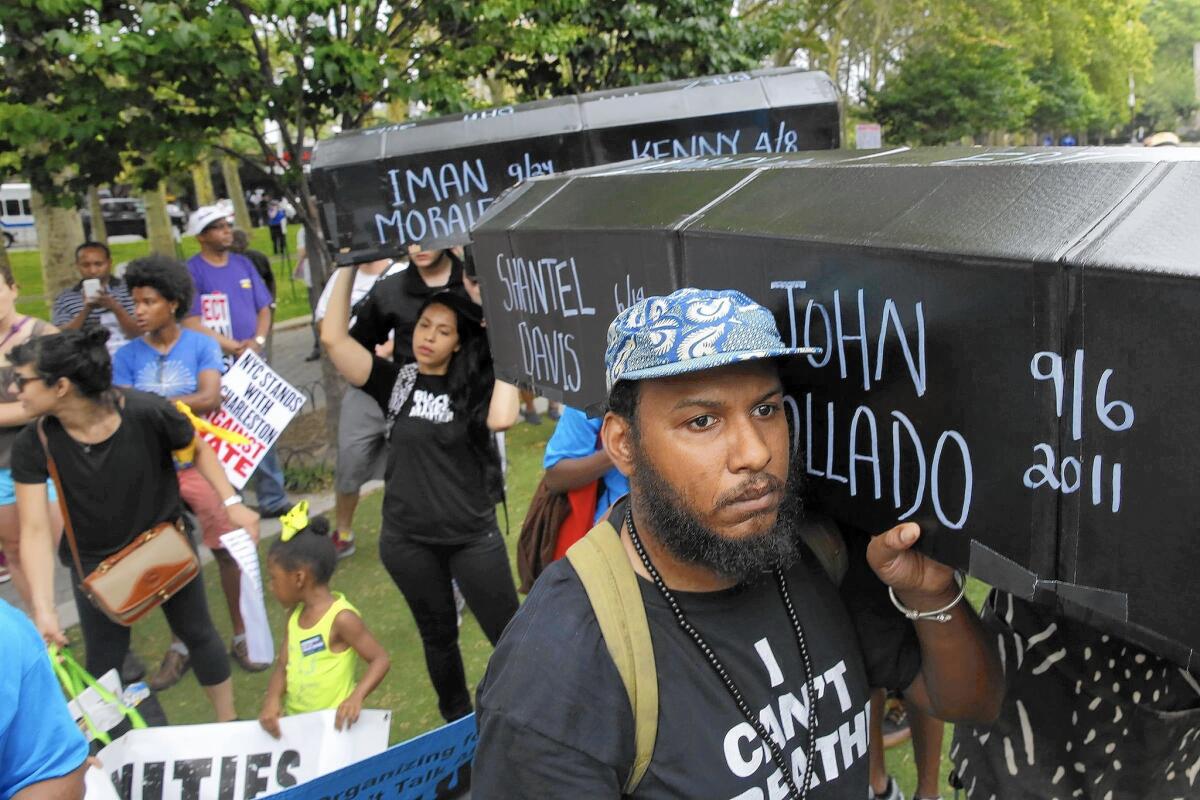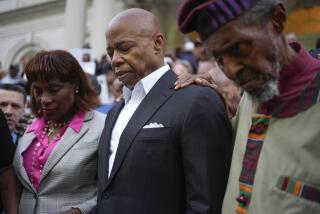Demonstrators echo Eric Garner’s ‘I can’t breathe’ cry again, a year after his death

- Share via
Reporting from New York — On the night that a grand jury declined to indict a policeman in the death of Eric Garner — an unarmed black man whose final gasps of “I can’t breathe” were captured on video — Mayor Bill de Blasio appealed for calm from the pulpit of a Staten Island church.
Seven months later, De Blasio appeared at the same church to comfort Garner’s family as the city marked the anniversary of his death.
“Eric Garner did not die in vain,” De Blasio said, saying that the fatal confrontation on July 17, 2014, had forced change. “That will make us a more just city,” he said. “That will make us a safer city.”
In both instances, De Blasio vowed that things would get better for the mainly black- and Latino-dominated communities that saw Garner’s death as a symbol of policing gone wrong. But each time, the mayor’s efforts to placate angry New Yorkers were answered with more anger: from police who see De Blasio as unsupportive of their difficult, dangerous job; and from citizens who see the city as too slow to bring the reforms they want.
The differences spilled into view again last week with the announcement that Garner’s family had reached a $5.9-million settlement with the city over his death, which was ruled a homicide due to compression of the neck during an apparent chokehold.
On Tuesday, a day after the settlement was announced, Garner’s mother, Gwen Carr, spoke with disdain about some of the public’s reaction to the settlement. “People are walking up and down the street saying congratulations,” she said. “Don’t congratulate us. This is not a victory. Victory will come when we get justice.”
And that is still far in the future, say critics, including those who acknowledge that progress has been made.
They include the Rev. Al Sharpton, who noted Saturday that the New York Police Department had launched a pilot program to outfit some officers with body cameras. In addition, Gov. Andrew Cuomo signed an executive order this month naming the state’s attorney general as a special prosecutor to investigate deaths of unarmed civilians by law enforcement officers, and in cases where “there is a significant question as to whether the civilian was armed and dangerous” at the time of death.
“A year ago we didn’t have cameras on police. A year ago we didn’t have a special prosecutor,” Sharpton said Saturday, as he left one of several rallies held to mark the anniversary of Garner’s death. “We’ve got more to work with now,” he said, calling the moves national models that could expedite change elsewhere.
But Sharpton, like the hundreds who gathered outside the federal courthouse in Brooklyn for Saturday’s event, said those changes are only the beginning of what they want to see. Broader demands include federal intervention to handle civilian deaths at the hands of law enforcement, which activists say should not be left to local prosecutors who work hand in hand with police; and an end to what critics say is racial profiling across the country.
Jonathan C. Moore, the Garner family attorney, agreed that New York at least was taking “steps in the right direction” toward reform. “But has it filtered down to the officer level? I don’t think so,” he said. “That’s talking about changing the culture of the Police Department, and that takes a long time.”
De Blasio and Police Commissioner William J. Bratton face challenges, even as they acknowledge the need for a shift in how police view some of the communities they protect, and vice versa.
The challenges include calls from some community leaders for a step back from the so-called broken-windows policing model, which calls for enforcement of minor violations to keep order and prevent the spread of serious offenses; and resentment by police union leaders over the way De Blasio handled protests after Garner’s death and after the December grand jury decision.
About three weeks after the grand jury opted not to indict the white policeman, Daniel Pantaleo, two New York policemen were shot to death by a gunman who had posted anti-cop rants online. In anger, officers turned their backs on De Blasio at both officers’ funerals.
The leaders of the city’s two main police unions, Patrick J. Lynch of the Patrolmen’s Benevolent Assn. and Ed Mullins of the Sergeants’ Benevolent Assn., criticized Cuomo’s appointment of a special prosecutor, calling it a needless level of control. Mullins also criticized the Garner family settlement as “obscene.”
The unions have stood by Pantaleo, who has been on desk duty since Garner died. He remains the focus of an internal NYPD investigation, and at last week’s rallies marking the death, protesters demanded that federal justice officials bring charges against him for violating Garner’s civil rights.
For people living in New York, where violent crime has plummeted since the 1990s, the question of how to change policing styles without loosening the grip that keeps streets safe is one they face on a daily basis. Residents of high-crime neighborhoods bristle at the ongoing use of the Police Department’s stop-and-frisk policy, which has been scaled back under De Blasio and Bratton but still occurs.
Norman Frazier, a member of a grass-roots community group, New York Communities for Change, says he believes the reduction in stop-and-frisk has not taken hold in some neighborhoods, including the Brownsville section of Brooklyn, where he lives.
“I still see young people being frisked down in Brownsville,” Frazier said as he stood at Saturday’s rally, listening to speakers lead the crowd in chants of “No justice, no peace,” and “I can’t breathe.” “I’m frustrated and not happy about that,” Frazier said.
He also said the Garner case highlighted a double standard in the way civilians are treated and the way police are treated. “We are here today because of the police officers who got away with it,” Frazier said, referring to Garner’s death. “That cop is still working. He’s still living. We want justice.”
Lewis Cruz, who was also at the rally, said he wanted to see a fundamental shift in police officers’ relationships with citizens.
“Even though we respect what they do, it’s important for them to respect us, to not violate our human rights,” Cruz said. “We really need them, but we have to be able to trust them.”
Activists say that trust has been difficult to develop following the Garner case.
Four months after Garner died as he scuffled with police who accused him of selling cigarettes illegally, a policeman shot and killed an unarmed black man named Akai Gurley who was entering the dark stairwell of a housing project the officer was patrolling. In that case, the policeman, Peter Liang, was indicted on manslaughter and other charges, but Gurley’s family has protested the judge’s decision to let Liang remain free on bail.
Other civilian deaths since Garner’s have included the shooting of Michael Brown, an unarmed black man in Ferguson, Mo., in August 2014; the shooting of Tamir Rice, an unarmed black 12-year-old in Cleveland in November 2014; and the death of Freddie Gray, who died after suffering a spinal cord injury while in police custody in Baltimore in April. The city’s medical examiner ruled the death a homicide.
At the Saturday rally, Garner’s mother stood on the stage alongside mothers of other unarmed men from across the country whose deaths have roused public outrage. They acknowledged that Garner’s death, captured on video by a witness and seen by millions of people around the world, had been a catalyst for calls for change. But they also lamented that there were so many of them on stage.
“This club is full,” said Carr, echoing others who urged activists to push for change to prevent the group from getting bigger. “No more members.”
Haller is a special correspondent.
More to Read
Sign up for Essential California
The most important California stories and recommendations in your inbox every morning.
You may occasionally receive promotional content from the Los Angeles Times.














